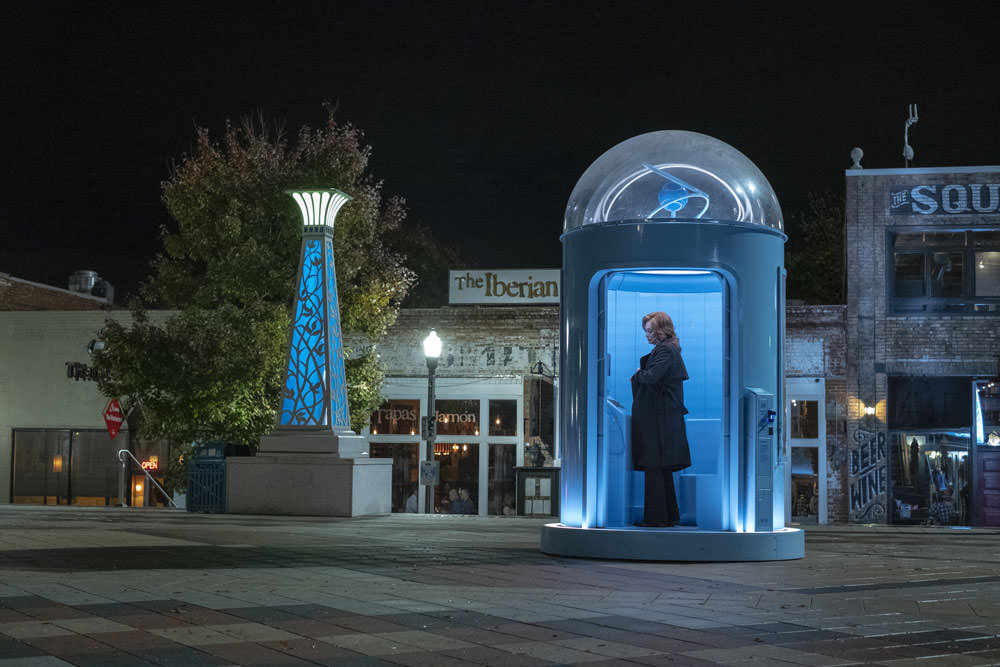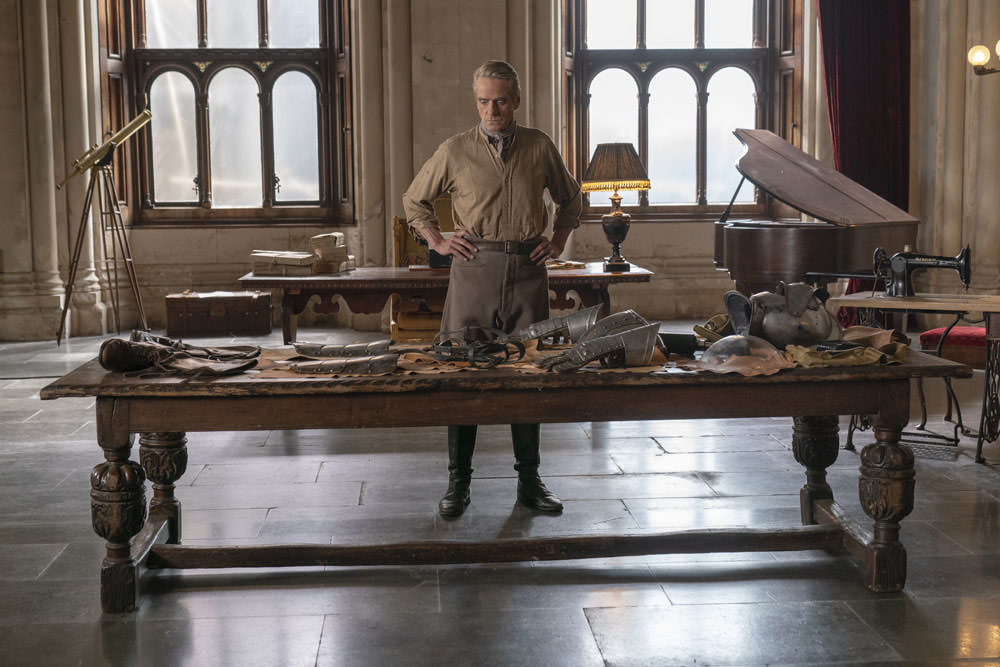
Jean Smart sauntered into the Watchmen adaptation on a pair of stilettos, wielding a ton of attitude and one hell of a sharp tongue, and the world of this series suddenly got weirder, more fun, and – not coincidentally – much closer in style and feel to the original graphic novel. Suddenly, this world has Warhol superhero paintings, and masked avengers stopping bank robberies, and phone booths to Mars, and gigantic blue dildos. And while that last one may have been the weirdest of all, it was also the one moment in the series so far that most felt like it belonged in the world created by writer Alan Moore and artist Dave Gibbons over thirty years ago.
Moore was, at the time (and for some time thereafter, we’d argue) a bit obsessed with the sexual weirdness inherent in the superhero concept and the original Watchmen was quite clear in the idea that many people put on superhero costumes to deal with their own sexual issues or preferences. Smart is playing Laurie Blake, who was formerly Laurie Juspeczyk, the daughter of two costumed heroes from the forties (her father raped her mother and she had a child by him many years later) who allowed her mother to push her into the family business. She started superhero-ing when she was in her mid-teens, almost immediately became infatuated with the big naked bodybuilder known as Dr. Manhattan and eventually became his lover for almost two decades. At the time of the graphic novel, she realized (way after everyone else did ) that her lover wasn’t capable of human interaction, left him, and immediately hooked up with another hero, Nite Owl. Together, they and the hero Rorschach (upon whose writings the 7th Kavalry is based) confronted Adrian Veidt just as he put his master plan to save the world by killing a significant chunk of it into place. Those four heroes are pictured in the Warhol painting in Laurie’s apartment. Nite Owl is referenced not only by Hoo the Owl, but by Senator Keene, who implies that he can pardon Nite Owl for the crimes (presumably masked vigilantism) that have kept him in federal custody for over twenty years. This implied promise is what gets Laurie to agree to go to Tulsa to look into Judd’s murder – and forces the question (just as the original series did) as to which man Laurie feels the most for. She’s working to spring her former lover Nite Owl, but she’s clearly still obsessed with her much-harder-to-get-over lover Dr. Manhattan.
There. You’re all caught up. We figure any confusion is now banished forever from your thoughts.
Okay, not really. We have to wonder just what show runner Damon Lindelof was thinking, making a series that’s both far beyond the original source material in tone and scope while at the same time being so wholly reliant on it in order to tell a new story. At the beginning, it seemed like the Watchmen TV series did not require a reading of the original graphic novel, but honestly, without Tom to explain most of this to Lorenzo, the latter would have been completely confused – as are, we imagine, a lot of viewers who haven’t read the OG. We suspect, given Lindelof’s time as the mastermind behind LOST and The Leftovers (two shows that feverishly encouraged theorizing and explaining), that the entire cottage industry of recappers and reviewers who DO know this stuff was built into the concept of the series. In other words, Lindelof felt like he could tell a new story for the viewers who haven’t read the book, while at the same time relying on… well, folks like us to explain all the weird references and backstories that keep popping up.
Laurie was something of an anomaly in eighties superhero comics: a woman over 30 who was sexual, competent, and extremely complicated. Like all of the heroes in the original novel, she was meant to be a commentary on the genre of superheroes and specifically, the sexualization and sidelining of all female heroes. She wasn’t always likeable, had a tendency to cut men down with a sharp word, had serious issues with her mother (who dabbled in a lot of notable soft core erotic work in her superheroine costume in the 40s and 50s), and allowed herself to be defined by the men in her life. Every bit of that is inherent in Jean Smart’s portrayal. She feels so right for the role and is helped tremendously by the fact that Laurie came into this script extremely well defined with a complicated and explosive backstory for the actress and writers to dive into and use in order to create this most compelling character.

As we said, she allowed herself to be defined by the men in her life, which is why her use of her father’s surname is so notable here. She used her mother’s maiden name most of her life when she didn’t know who her father was. It’s also notable that the framing device for her introduction is a long, rambling joke. Her father’s vigilante name was The Comedian. And it’s also notable that the joke is about the three men in her life who most influenced it: Nite Owl, who was too soft to go to heaven; Adrian, who was too much of a monster to go to heaven, and Dr. Manhattan, who was already in hell. She was the little girl in the joke; the little girl who stood behind the other men, the little girl who no one noticed. The little girl who threw the brick in the air that killed God. The clear implication here is that Laurie is very aware of her shortcomings and her history, while also being fully committed to overcoming her past, killing her gods, and ensuring no one else ever puts a silly mask on again. And yet, she’s still obsessed with her past. Of all the characters introduced or re-introduced so far, she comes across like the most dangerous because she knows who she is and she knows why the world is the way that it is.
Granted, she’s got some competition in Adrian Veidt. The show had been coy about who Jeremy Irons was playing (for reasons we can’t fathom since it was obvious from the jump), but this episode not only saw him use his full name, but also showed him in full Ozymandias costume. As for whatever’s going on with him, we can only say that it’s a good thing Irons is having so much fun with the role, because all of his scenes come off like sideline distractions from the main story right now. We know they’re not, given the character’s history and his prominence in this series, but with a brewing race war and a country dealing with a half-century-long obsession with masked vigilantism that doesn’t seem to have done it much good in the long run, Veidt’s bizarre experiments on his clone-drones and the revelation that he is being kept in some form of captivity (which implies that his massive country estate may not be entirely real – or on earth, given the space suits he’s building) has yet to fully engage us. It’s interesting and fun to watch, but it all feels very separate from everything else going on and sometimes it’s hard to maintain an interest in his goofiness.
But if you’re confused, try and look at it this way: Pretend Avengers: Infinity War happened over 30 years ago and not only didn’t the heroes win, but they all got outlawed or killed in the years since. That’s the world you’re looking at now. Something huge and comic-booky happened three decades ago, killing millions and changing the world forever.
And also: The title of this episode refers to Dr. Manhattan’s penis. Girlfriend got wrecked by that big blue dick in her youth and she’s never truly gotten past it. And hey, who can blame her? You fuck Superman for twenty years and every other guy’s gonna come up short. Why do you think she spent the entire episode inside a big blue dick telling jokes to him?
RuPaul’s Drag Race UK: Snatch Game Next Post:
Kiki Layne in Gucci at the 2019 LACMA Art + Film Gala
Please review our Community Guidelines before posting a comment. Thank you!



